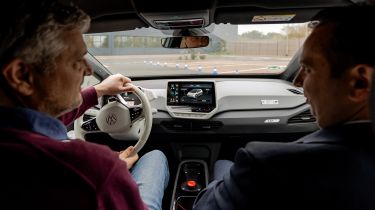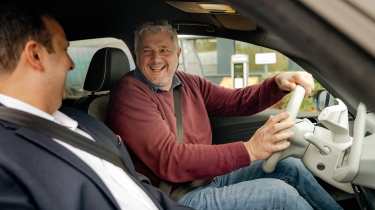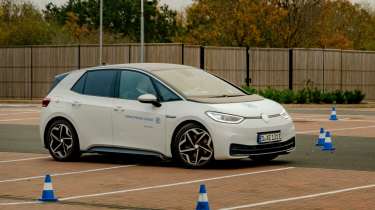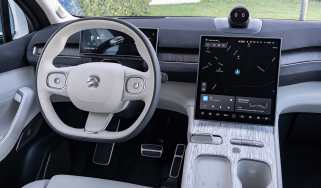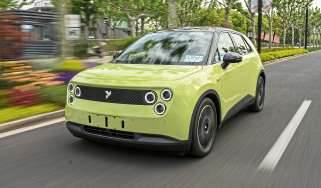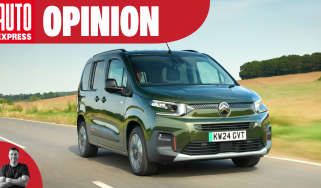What is steer-by-wire? And are you ready for it?
Advanced electronic steering tech is just around the corner. We ask whether consumers are prepared to embrace it
Chinese brand Nio could be the first car manufacturer to offer a pure steer-by-wire (SBW) system in Europe, if it decides to begin deliveries of its flagship ET9 luxury crossover in key markets next year.
Toyota should be relatively close behind with its One Grip Motion steer-by-wire system, which is expected to be available on the Toyota bZ4X and Lexus RZ 450e in the UK at some point in late 2025 or early ’26. Other manufacturers and suppliers are developing variations of the new tech, which removes the need for a steering column – or any mechanical link – between the driver and the steered axle in their car.
We can’t say for sure whether Nio will be first, because although the ET9 is available for pre-order in China, with deliveries set for early 2025, the firm has yet to confirm whether the model will come to Europe. Nio won’t be able to claim a global first, either, because the Tesla Cybertruck was launched with SBW tech in the US last year. Infiniti has been testing similar applications for some time with its Q50, too, but with a halfway-house set-up that retains a special clutch-operated steering-column link as a safety back-up.
Nio revealed the ET9 prototype a year ago as a flagship model for new technologies, and it features 900-volt electrical architecture that allows for ultra-rapid 600kWh charging. Also on the spec sheet are twin motors delivering close to 600bhp – enough to propel this 5.3-metre-long, 2,700kg leviathan to its 130mph top speed quickly enough to make trust in its steering capabilities more than critical.
Nio and ZF Group announced a collaboration on steer-by-wire technology in 2022, so it’s a pretty safe bet that ZF is in the frame for the system onboard the ET9. However, the company remains tight-lipped for now at least, acknowledging only that its SBW system will appear in production first “with a premium manufacturer” at some point in 2025, and that it has multiple contracts to fulfil thereafter.
Why is the car industry turning to steer-by-wire?
While the SBW concept has been around for years, it’s the transition to electric drivetrains that has really opened the door to the technology. The more generic an EV platform can be, the better, from both a cost and a manufacturing perspective.
By removing the requirement for a steering column, a whole range of engineering, packaging and crash-safety challenges disappear at a stroke. Rakish sports car or high-riding SUV? No problem, says ZF: the interior designer can simply place the steering wheel where it’s needed. Left or right-hand drive? Same again – and designers are already thinking about the luxury of extra kneeroom for the driver, along with yoke-type steering ‘wheels’ that require only limited hand movements to steer – regardless of whether you’re on the motorway or parking in town.
We’ve even seen more far-out predictions, such as wheels that stow themselves neatly out of the way in the dash when you switch to fully autonomous driving mode – should such a thing ever become a reality.
The purely electronic connection between the driver and a car’s steered wheels also opens up possibilities for an ‘intelligent chassis’ approach. For example, while existing chassis-control systems can tell the instant your rear wheels slip sideways in a skid, there’s a limit to what the anti-lock braking or torque vectoring can do about it. A driver’s response may be compromised by the lack of skill or experience required to ‘catch’ the slide, and such situations often lead to steering over-corrections and, sadly, accidents. Working harmoniously with other onboard systems, SBW can instantaneously understand the driver’s intention to catch the slide despite the potential for wildly optimistic steering-wheel correction, and perfectly moderate the application of road-wheel angle to bring the car neatly into line.
Other benefits of SBW include the ability to vary steering ‘ratios’, so when parking only a small input is required for big angles, while at higher speed the same input may be required to change lanes. During Level 3 autonomous operation, it’s even possible for the wheel to ‘park’ in the straight-ahead position, which could help avoid excessive twirling during self-parking manoeuvres.
How does SBW work? We try out a prototype
As you’d expect, the new generation of ‘pure’ steer-by-wire systems share various features to make up for the lack of physical connection between driver and tarmac. Typically, this involves two independently controlled actuator motors on the steering rack that can take power from both a car’s electrical system batteries or its (EV) drive batteries, with a dedicated system back-up battery that can work independently if all else fails. It sounds complex – and it needs to be, given the range of potential electrical-system failures that steer-by-wire must be configured to cope with.
The steering wheel has actuators that can not only measure driver inputs, but also put energy back into the wheel, making it possible to easily replicate any type of ‘driver feel’ or weight a maker requires, and also opening the door for drivers to personalise the experience. The final piece in the puzzle is the computer, which must accurately discern driver intentions, simultaneously process info from the car’s myriad onboard sensors, and turn the wheels.
When we recently visited ZF’s impressive chassis-tech centre in Warwickshire, we got the chance to try out an early prototype of its forthcoming SBW system. Driving in a tight figure of eight, and at town speeds around a car park’s perimeter, the prototype demonstrated how SBW can provide varying degrees of steering angle in response to the same driver input – and that coping with even significant variation in response at varying speeds felt both intuitive and simple.
The steer-by-wire revolution – it’s coming to a road near you soon
Helping to steer the SBW revolution at ZF is Chassis Engineering vice president Bal Panaser, who leads the team at the firm’s UK R&D centre. With his finger on the pulse of global product trends, he’s well placed for a view on how soon the tech will go mainstream.
“You’ll see family passenger vehicles with steer-by-wire in China next year,” he predicts. “In Europe, maybe at some point towards the end of 2025, but I think the take-up will be on a niche basis due to the conservative nature of European OEMs. In China, things will ramp up significantly in ’26 and ’27.”
However, he reckons developments at ‘China speed’, not least from start-ups with no heritage of using anything but SBW, could affect the pace of roll-out here. “If suddenly all the cheap Chinese brands have got it, plus the functionality and performance people are after, then yes,” he says. “Certainly in China today, your vehicle appearance, look, features and functionality appear to be more important than the brand. If SBW becomes a differentiator, the other guys will have to follow – very fast.”
So will Europeans be confident with the pace of change? They shouldn’t fear it, believes Panaser, pointing to the ever-increasing quality of products and reliability of electronic systems. In the event things do go wrong, then failing in a manner that is still safe is the overriding objective, he says.
“It’ll take time to convince people that the reliability of these systems means you don’t have to worry about buying a five-year-old car,” he adds, suggesting that early adopters will as always provide a proving ground to give confidence to others. “People will see SBW is pretty robust, and look at the performance it’s providing,” he says.
Find a car with the experts

